The core of customer loyalty is building a trusting relationship with consumers.
While customers like to know what they’re getting, companies depend on consumers’ loyalty for the larger part of their revenue. A loyal customer looks for familiarity, reliability, and consistency from brands. They will thus buy a product even if it’s not currently widely available or affordable.
As customer loyalty statistics show, businesses are constantly fighting for this trust. The battle is more serious than ever, as the COVID-19 pandemic has drastically reshaped customers’ habits.
We have compiled a list of the most illustrative stats on the topic. In this overview, we’ll examine how the relationship between brands and customers has changed since the pandemic began.
Top Customer Loyalty Stats (Editor’s Choice)
- 75% of US consumers changed their shopping behavior during the pandemic.
- 63% of consumers say they’ll purchase more private label items in the future.
- Only 15% of online shoppers are repeat customers.
- Apple, Amazon, Google, Walmart, and YouTube were the brands with the highest customer loyalty in 2020.
- The global loyalty programs market is projected to reach up to $216 billion by 2022.
- 42% of US internet users have participated in loyalty programs.
- 67% of consumers want their loyalty program information available via a mobile app.
- 43% of consumers are willing to pay extra for greater convenience.
Customer Loyalty Statistics in 2024
1. 75% of US consumers changed their shopping behavior during the pandemic.
(McKinsey)
Price was always one of the main concerns when choosing a brand. Unsurprisingly, with the economic instability that followed the pandemic, value became an essential deciding factor.
This led to consumers reconsidering their choice of brands, affecting customer loyalty in various industries. Finally, 2020 saw a massive drop in brick-and-mortar footfall. With the rising reliance on online and click-and-collect shopping, convenience and accessibility also gained importance.
2. 79% of US consumers would consider switching brands for a better price.
(PwC)
Customer loyalty research also shows that 52% of consumers would switch brands over product or service quality. The key consideration, as always, is value for money — and this has only been more pronounced since the pandemic started.
3. A single bad experience will drive 17% of consumers to stop buying from a brand.
(PwC)
For almost 80% of US consumers, the pillars of a positive customer experience include speed, convenience, and well-informed, friendly staff. Customer loyalty statistics illustrate this further: 59% of consumers would quit a brand after several bad experiences.
4. The customer loyalty and retention marketing spend was expected to increase by 30% in 2021.
(Forrester)
As many consumers had to change their shopping habits amid the pandemic, the importance of customer loyalty became more prominent than ever. According to Forrester, most companies should have made the customer experience an integral part of their marketing efforts in 2021. The goal is to reform every business aspect — from leadership to operations — with the consumer in mind.
5. 63% of consumers say they’ll purchase more private label items in the future.
(Ketchum)
Ketchum’s customer loyalty study proves people’s attitudes towards brands have changed during the pandemic. Namely, 63% of the respondents say brands don’t matter that much anymore, and private labels — including budget-friendly store labels — are just as good.
Almost half (45%) of them say they’ve recently changed at least one brand they used to buy from regularly. They seem happy with this choice, as 62% have no plans of going back to the brand they ditched.
6. Only 15% of online shoppers are repeat customers.
(Yotpo)
Repeat customer statistics show that only 15% of online shoppers buy from a brand more than once. However, this 15% can make up to one-third of a business’s entire revenue. These online shoppers are also more likely to recommend a brand to their friends — and as word-of-mouth marketing statistics strongly suggest, it’s something every business should strive for.
7. 83% of US consumers say they’ll keep purchasing from brands they tried out during quarantine.
(GlobeNewswire)
During the lockdown, trying out new products led more than four in five consumers to form new brand preferences. It is thus no wonder companies are investing more in customer experience, loyalty, and retention. Still, not all age groups are equally interested in trying something new.
Statistics about customer loyalty reveal that nearly 70% of consumers in the 35–44 group gave new products a shot. However, only about 33% of those aged 65 and over did the same.
Brand Loyalty Statistics
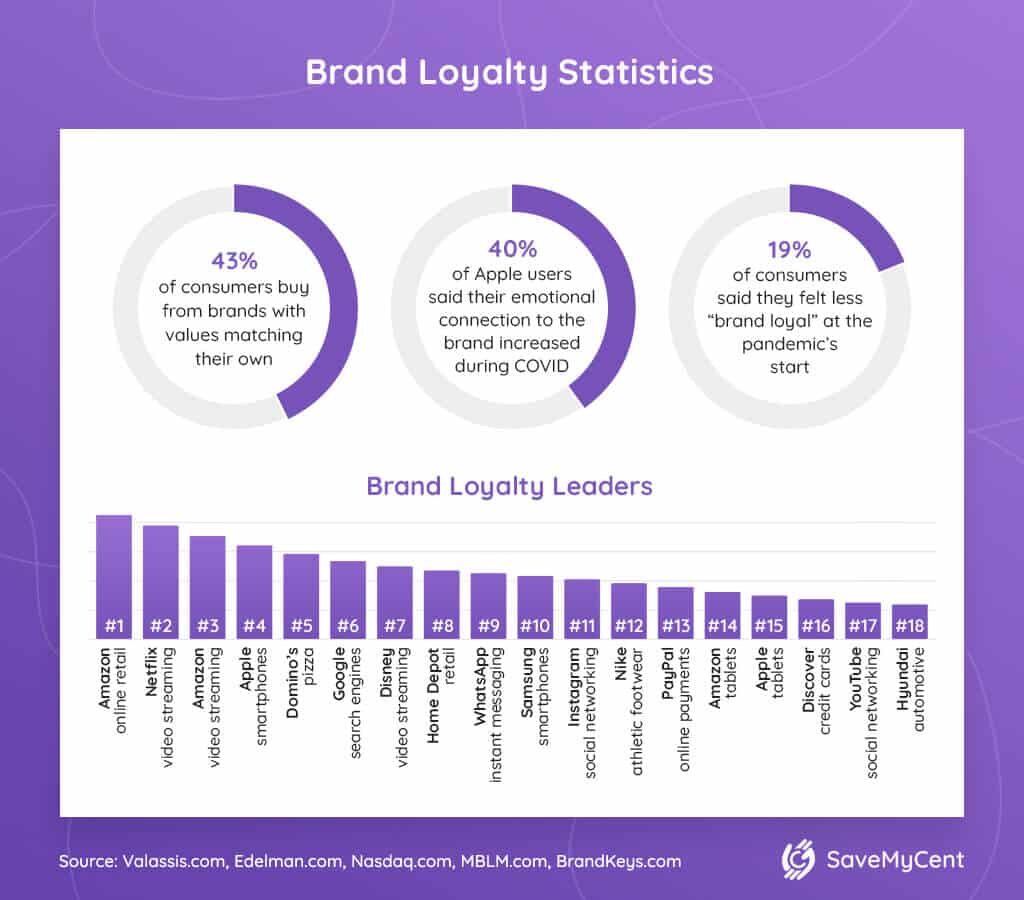
8. 43% of consumers buy from brands with values matching their own.
(Valassis, Edelman)
A brand’s values are becoming increasingly crucial when making purchasing decisions, especially among younger generations. It is an essential part of modern branding — for example, 86% of consumers expect CEOs to speak out on burning social issues such as sustainability, inclusivity, and fair working conditions.
9. At the pandemic’s start, 19% of consumers said they felt less “brand loyal.”
(Valassis)
The limited availability of many products drove 13% of shoppers to try out a new brand, loyalty research shows. Offering coupons is a proven way of attracting new customers and rewarding existing ones. So, in the face of economic instability and related customer concerns during this period, brands strived to encourage loyalty with promotions and discounts.
10. Nearly 40% of Apple users reported an increased emotional bond to the brand during the pandemic.
(Nasdaq, MBLM)
With 74 points, Apple’s brand loyalty statistics put the company ahead of other tech giants like YouTube (58.6 points), Netflix (55.2), and PlayStation (54.2). Also, as they spent more time at home, 55% of customers said they used Apple’s products more than before the pandemic.
11. Amazon has the highest brand loyalty of all online retail services.
(Brand Keys, Brand Keys)
With the unprecedented rise in online shopping, customers focused on the retailers deemed most reliable. Amazon has long been a household name, so it’s no surprise it attracted many first-time online shoppers and retained its existing customer base.
12. Apple, Amazon, Google, Walmart, and YouTube were the brands with the highest customer loyalty in 2020.
(MBLM, Brand Keys)
According to MBLM’s report, these five titans were the brands with the most loyal customers in 2020. Loyalty is one of the best success predictors. And with last year’s tectonic changes, brands that saw the strongest loyalty growth included Smirnoff (+26 points), Dollar Tree (+20), GEICO (+19), YouTube (+18), and Jack Daniels, Ketel One, and Whole Foods (+16 each).
Loyalty Program Statistics
13. 78% of consumers are more likely to return to a brand offering a loyalty program, stats show.
(Bond)
And if the loyalty program is good, there’s an extra benefit for the business. Namely, 72% of customers say they’re likely to recommend a company with a satisfying loyalty program. The program needs to meet or exceed expectations, ensure a smooth and enjoyable experience, and provide real value to the customer. Simply put, shoppers want to save cash and have fun.
14. The global loyalty programs market is projected to reach up to $216 billion by 2022.
(Beroe, Fortune Business Insights)
Organizing a loyalty program and keeping it attractive and lucrative is no simple task. For this reason, while some companies prefer setting up these programs by themselves, many delegate the task to loyalty program management companies. On that note, the management market is expected to grow at a CAGR of 19.9% over the next few years, reaching $10.02 billion by 2027.
15. 42% of US internet users have participated in loyalty programs.
(eMarketer)
The number of people who use ecommerce loyalty programs in the US is in the tens of millions. To put that into perspective, online shopping stats show that 256 million Americans bought items on the internet in 2020, with the number projected to reach new heights in 2021.
16. Loyalty program members contribute 12%–18% more to the annual revenue growth than non-members.
(Accenture, Business Wire)
As brand loyalties fluctuate and expectations rise, businesses must treat their existing, loyal customers right. To do this, it’s crucial to listen to the customers’ needs, as emotions play a defining role in building loyalty. Namely, loyalty statistics reveal that 88% of consumers have a better opinion of a product’s quality if they feel the brand is paying attention to their needs.
17. 95% of retailers with traditional loyalty programs were considering starting a paid loyalty program in 2021.
(Clarus Commerce)
According to a recent study, 67% of customers aren’t satisfied with traditional programs. While this doesn’t mean they would all switch to premium, keeping the most loyal customers engaged and satisfied is crucial. Having access to exclusive offers, discounts, free shipping, and other loyal customer perks in exchange for a small fee could help companies achieve this.
18. 22.9 million Americans are members of the Starbucks loyalty program, statistics from Q2 of 2021 show.
(Starbucks, Forbes, PYMNTS)
This number is up by 18% compared to 2020’s second quarter. The reason so many experts discuss and analyze Starbucks’ loyalty program is its market-leading, innovative approach.
For one, the company has partnered up with retailers like Target to grow its foot traffic. It has also implemented AI in a way that could help revolutionize the entire industry. Finally, Starbucks is constantly setting new customer loyalty trends. Customers can now pay via the official app and still earn rewards — a move that has significantly boosted the loyalty program’s usage.
Loyalty Programs: The Customer Perspective
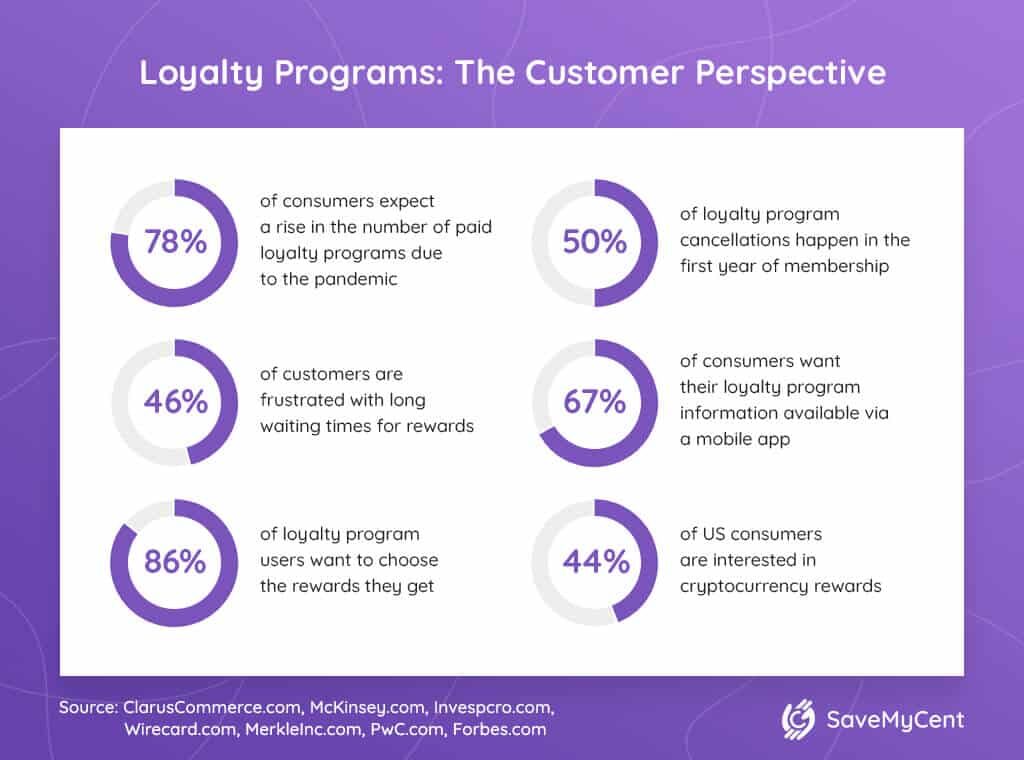
19. 78% of consumers expect a rise in the number of paid loyalty programs due to the pandemic.
(Clarus Commerce, McKinsey, Invesp)
Companies want loyalty programs to attract and keep customers, while buyers want these programs to pay off. Expectations vary, but most buyers want at least a 150% return on the paid program subscription fee. This is more lucrative than it seems — customer retention statistics reveal that acquiring customers is up to five times more expensive than retaining them.
20. 50% of loyalty program cancellations happen in the first year of membership.
(McKinsey)
Customer loyalty facts point to value, speed, and convenience as the most important factors in keeping a loyalty program successful. Most customers cancel their membership because the rewards don’t justify the fee. This is why benefits, surprise offers, and gifts are all vital in the first weeks. Also, in the age of Amazon Prime, free shipping is a given and by no means a perk.
21. 46% of customers are frustrated with long waiting times for rewards.
(Wirecard)
Shoppers have always appreciated speed and convenience — it’s only the definition of quick service that has changed over time. With so many things just a click away, a few days seems like a long wait for a reward. Many consumers (24%) are willing to wait for up to three days. However, 39% say they expect to receive their prize within a day or less of claiming it.
22. 67% of consumers want their loyalty program information available via a mobile app.
(Merkle, PwC)
For the new generations of consumers, smartphone shopping is a must. Customer engagement statistics reveal this is a priority for 63% of Gen-Z customers. They want their mobile experience to be seamless and perfectly in tune with desktop and in-store purchasing. And even without the generational filter, research strongly suggests mobile commerce is the future of online shopping.
23. 86% of loyalty program users want to choose the rewards they get.
(Merkle)
With so many loyalty programs out there, tailoring yours to customers’ actual needs is crucial. According to customer loyalty stats, 59% of consumers also agree that surprise special offers and gifts are an excellent way to improve customer satisfaction and loyalty.
24. 44% of US consumers are interested in cryptocurrency rewards.
(Forbes)
A recent poll reveals that 44% of consumers are willing to turn their loyalty rewards into digital currency. With more Americans being aware of and interested in cryptocurrencies, it is one of the most intriguing developments we can expect in the near future.
Convenience, Trust, and Customer Loyalty Statistics
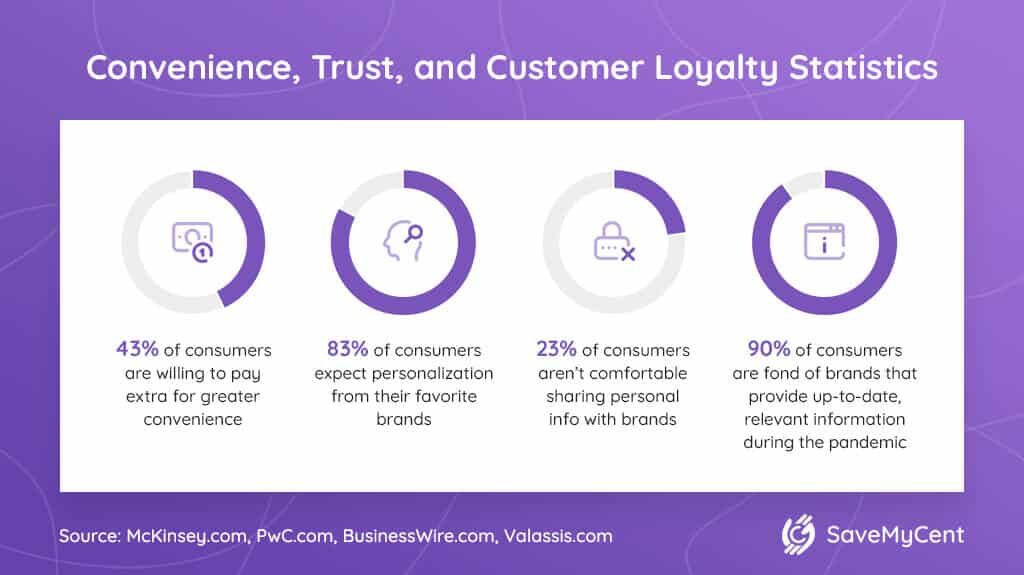
25. 43% of consumers are willing to pay extra for greater convenience.
(PwC)
Convenience is a vital part of the overall customer experience, and consumers are willing to pay more to enjoy it. The same goes for 42% who would pay for a more welcoming experience, as human interaction can be a crucial factor in customer loyalty, in retail especially.
Putting the consumer first is the key to success — 65% of them say they’re more influenced by a positive customer experience than any form of advertising.
26. 83% of consumers expect personalization from their favorite brands.
(McKinsey, PwC)
Personalization is a pervasive trend in commerce, and it plays a significant role in customer retention, stats reveal. To successfully implement this approach, brands must know what the customer wants — in other words, they must gather consumer data.
This is where security and general reputation come into play. According to a recent survey, 88% of customers decide how much data they’ll share with a company based on its trustworthiness.
27. Regardless of the benefits, 23% of consumers aren’t comfortable sharing personal info with brands.
(Business Wire)
This number is down from previous years, suggesting that more consumers are in favor of personalization. In fact, 49% agree that personalization makes finding products they want to buy much easier. But to earn and maintain consumers’ trust and loyalty, companies must ensure all customer data is handled in the most secure possible way.
28. 90% of consumers are fond of brands that provide up-to-date, relevant information during the pandemic.
(Valassis)
You can’t build lasting relationships with consumers if they don’t trust you, and customer loyalty statistics are clear in this regard. With the pandemic raging, relevant, transparent, and concise updates help pass vital information to the public. Customers also feel more at ease knowing that a brand is taking all necessary precautions to protect theirs and the health of its employees.
In Conclusion
While consumers are rethinking the way they interact with brands, the market for customer loyalty programs is growing. As seamless customer experience, social responsibility, and loyalty perks keep consumer-business relationships stable, innovations like AI and gamification help make everything more convenient. Customer loyalty stats also show that paid programs are rising in popularity, providing personalization and other benefits to keep consumers happy.
Ultimately, customer loyalty is all about building trust, providing a unique experience, and offering plenty of well-timed discounts. After all, if a customer has to part with their cash, they’d rather pay for a product they trust — it’s as simple as that.
FAQ
What is customer loyalty?
Customer loyalty refers to a continuous positive relationship between a business and a customer. It implies trust that is built over time through repeated positive experiences. Also, it involves the preference for a brand based on relatability and emotional connections.
What percentage of customers are repeat customers?
Repeat customers are a valuable asset to any business, but their rate varies across the board. According to recent research, about 15% of online shoppers are repeat customers. Although their percentage is small, their spending accounts for up to a third of a brand’s annual revenue.
How much more do loyalty customers spend?
According to estimates, loyal customers are worth ten times the amount of their first purchase. Their purchases also make up the bulk of a brand’s total transactions. And that’s not all — the recommendations they share with friends and family make them even more valuable.
How do you calculate customer loyalty?
The formula for determining your customer loyalty score is simple. Just take the number of customers who have bought from your brand more than four times within the past year, and then divide it by the number of unique customers during that same time frame.
What are the four stages of customer loyalty?
As customer loyalty is an ongoing emotional process, there are four phases, each stronger than the one preceding it. These include the following:
- Cognitive loyalty — a customer is loyal to your brand because you provide excellent value
- Affective loyalty — the customer starts developing a deeper bond with your brand and counting on your product to meet their expectations
- Conative loyalty — the customer has now chosen you as their go-to brand and is willing to recommend you to others
- Action loyalty — the customer now sees your brand as an integral part of their lifestyle and will buy from you without even considering other choices
What is the most direct cause of customer loyalty?
Intentionally building trust and emotional bonds with consumers is the most direct cause of customer loyalty. To achieve this, brands must consistently meet and exceed their expectations. Customer loyalty statistics confirm this — 83% of consumers say their loyalty comes from trust.
Sources:
- Accenture
- Beroe
- Bond
- Brand Keys
- Brand Keys
- Business Wire
- Clarus Commerce
- Edelman
- eMarketer
- Forbes
- Forbes
- Forrester
- Fortune Business Insights
- GlobeNewswire
- Invesp
- Invesp
- Ketchum
- LoyaltyLion
- MBLM
- McKinsey
- McKinsey
- Merkle
- Merkle
- Nasdaq
- PwC
- PYMNTS
- Qminder
- Qualtrics XM
- Rare: Consulting
- Starbucks
- Valassis
- Valassis
- Wirecard
- Yotpo
- Yotpo

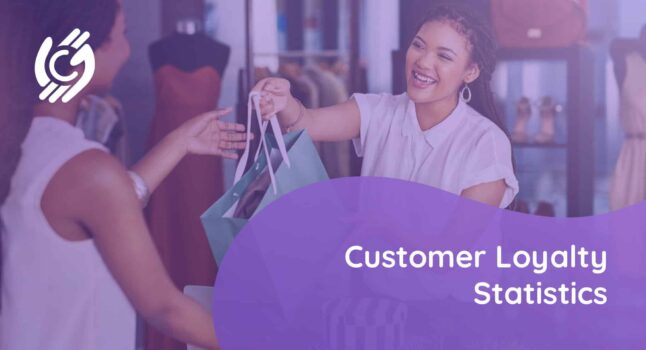


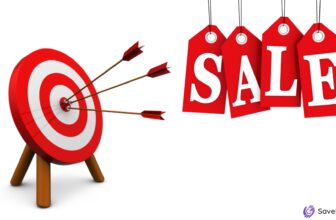


![How to Get Free Clothes From Shein? [2024 Guide]](https://savemycent.com/wp-content/uploads/2023/09/How-to-Get-Free-Clothes-From-Shein-336x220.png)
